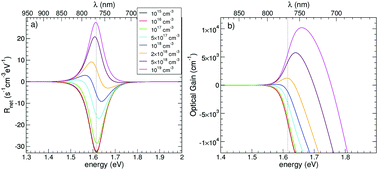Photoluminescence, optical gain, and lasing threshold in CH3NH3PbI3 methylammonium lead-halide perovskites obtained by ab initio calculations
Abstract
Using ab initio band energy calculations and van Roosbroeck–Shockley recombination theory, we model transient photoluminescence for lead-iodide CH3NH3PbI3 perovskites. We provide clear evidence that the most important features of the photoluminescence process, i.e. strong absorption, low recombination rates, and long lifetimes, can be all coherently derived from the band-to-band recombination process, and the sometimes invoked contradiction between strong absorption and low recombination rate in a direct band-gap material has no reason to exist; optical gain and charge carrier lasing threshold are also reproduced in satisfactory agreement with the observed values, at least within a significant charge-injection range. Our description provides a solid theoretical assessment to the widespread but debated idea that photoluminescence in these materials is predominantly produced by unbound charge recombination.



 Please wait while we load your content...
Please wait while we load your content...